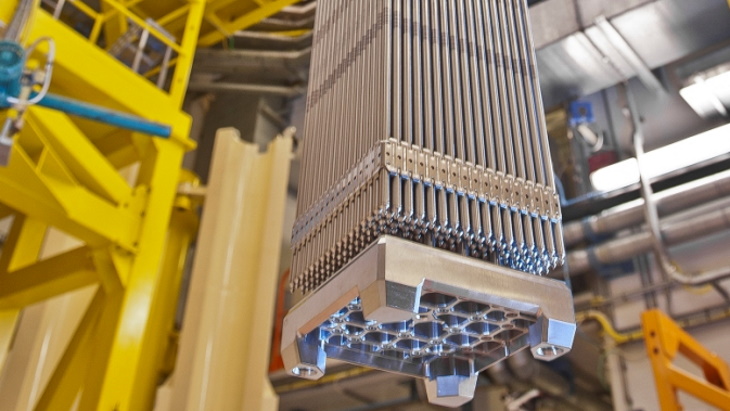France, Japan to cooperate on MOX fuel recycling studies
Japan's Federation of Electric Power Companies (FEPC) announced it will work with France's Orano on demonstration research and development for the reprocessing of used mixed oxide (MOX) fuel.

A MOX fuel assembly (Image: E Larrayadieu / Orano)
In order for the country to continue using nuclear power generation, it is necessary to safely and reliably process and dispose of fuel, FEPC said. This includes used MOX fuel that is removed from Japanese reactors that are implementing the use of MOX fuel.
While only four Japanese reactors have so far been restarted using MOX fuel, FEPC envisages at least 12 units running on the fuel by FY2030. FEPC represents the 11 power companies, comprising nine utilities (excluding Okinawa Electric Power), Japan Atomic Power Company and the Electric Power Development Company (J-Power).
As long ago as the 1950s, Japanese nuclear energy policy recognised that the energy resource-poor country must recycle uranium and plutonium recovered from used nuclear fuel. Up until 1998, Japan sent the bulk of its used fuel to plants in France and the UK for reprocessing and MOX fabrication. However, since 1999 it has been storing used fuel in anticipation of the full-scale operation of its own reprocessing and MOX fabrication facilities.
Construction of a reprocessing plant at Rokkasho began in 1993 and was originally expected to be completed by 1997. The facility is based on the same technology as Orano's La Hague plant in France. Once operational, the maximum reprocessing capacity of the Rokkasho plant will be 800 tonnes per year. Construction of a 130-tonne per year MOX plant, also at Rokkasho, began in late 2010. However, completion of both the reprocessing plant and the MOX fuel fabrication plant has faced several delays.
"It is necessary to establish reprocessing technology for used MOX fuel as soon as possible," FEPC said. "Reprocessing of used MOX fuel has a proven track record in Japan and overseas, and is technically possible. Until then, it is necessary to establish technology for the reprocessing process based on its characteristics."
FEPC noted the 6th Strategic Energy Plan - approved by the government in October 2021 - aims to establish the technology in the "latter half of the 2030s".
It said that through the demonstration research with Orano, the properties of used MOX fuel and the impact on reprocessing will be investigated. "Acquiring the necessary technical knowledge for the practical application of MOX fuel reprocessing, [we will] demonstrate that MOX fuel used in power plants can be reprocessed in commercial plants."
The selection of Orano follows a 3 May meeting between Japan's Minister of Economy, Trade and Industry Nishimura Yasutoshi and France's Minister of Energy Transition Agnès Pannier-Runacher. During the meeting, a joint statement on nuclear energy cooperation was signed, including "the promotion of the reprocessing policy that minimises waste and reduces the need for natural uranium".
Since the March 2011 accident at the Fukushima Daiichi plant, four reactors - Genkai 3, Ikata 3 and Takahama 3 and 4 - have resumed operation using MOX fuel.
The start of use of domestically-produced MOX fuel is expected to be after 2026, FEPC said.
The utilities aim to have at least 12 reactors utilising MOX fuel by FY2030. They also agreed to promote using plutonium and reduce the size of their stockpiles at home and abroad through close collaboration and cooperation among the utilities.
Researched and written by World Nuclear News
- China Institute of Atomic Energy
- Nuclear Power Institute of China
- Southwestern Institute of Physics
- China Nuclear Power Operation Technology Corporation, Ltd.
- China Nuclear Power Engineering Co., Ltd.
- China Institute for Radiation Protection
- Beijing Research Institute of Uranium Geology (BRIUG)
- China Institute of Nuclear Industry Strategy (CINIS)
- China Nuclear Mining Science and Technology Corporation


